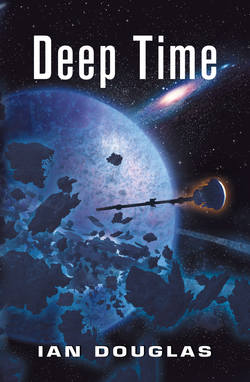Читать книгу Deep Time - Ian Douglas, Matthew Taylor - Страница 7
Prologue
Оглавление“What the hell is that?”
“Dunno, Control,” replied the voice from Kapteyn Orbital. “It … it just popped up on our screens out of nowhere. It’s coming in fast … almost a half c. It’s—”
Commander Gerwin Dressler flinched as the projected holoscreen floating above his workstation lit up with an intense blue-white light. Something had just slammed into the research platform orbiting the local star at half the speed of light, converting five thousand tons of metal, ceramics, plastic, and organic crew members into a rapidly expanding cloud of hot plasma.
The base AI was saying that the object was in fact a diffuse cloud of particles, a cloud many astronomical units across and massing trillions of tons. There was other stuff in there, too, though … enigmatic structures, half-glimpsed constructions, things large and inexplicable shrouded within the particulate cloud.
And that cloud would be reaching Heimdall in seconds.
With a thoughtclick, Dressler sounded the base alarm.
“What is it?” the voice of Captain Roessler said in his head. He sounded groggy; it might be high noon local time, but by the base clocks, set to Greenwich Mean Time and measuring days and nights convenient to human biology, it was the wee hours of the morning.
“We’ve just lost Kapteyn Orbital, sir,” Dressler replied. “Here’s the data …”
“The Americans?”
“No, sir. Something … something else.”
Something very else.
He waited as the station’s commanding officer reviewed the scant data transmitted from the orbital. God, the sky outside was so beautiful …
The dome housing the base command and control center was set to project the view outside at the moment, showing a sky—deep blue to brilliant violet—dominated by the immense curve of the gas giant, Bifrost. Kapteyn’s Star, an M1.5 red dwarf less than a third the mass and radius of Sol, shone almost directly overhead. At a distance of 3.5 AUs, Kapteyn’s Star was shrunken to little more than a bright red pinpoint. Sharp eyes could distinguish its disk, but the much closer gas giant commanded the eastern sky at the moment, currently at half phase. The bands and swirls of pale brown, salmon, and white sweeping up from the glaciers on Heimdall’s horizon to the curve of Bifrost’s limb were clearly visible. Phantasmagorical aurorae circled the gas giant’s poles to either side and were answered by the dancing curtains of light across Heimdall’s northern sky.
Heimdall was a moon of Bifrost, circling its mammoth primary at a distance of just over 600,000 kilometers once every three days. Tidal interactions with the giant warmed Heimdall’s surface far more than did the wan and feeble sun.
God, he thought again. He could see the flare marking the death of Kapteyn Orbital with his unaided eye, a smear of white light bisected by the rim of Bifrost’s horizon. Automatically, he plotted the explosion’s position against the background stars, and the result chilled him.
“Whatever it is, Captain,” he told Roessler, “it’s coming in more or less on a vector from Omega Centauri.”
The research station’s personnel had been briefed, of course, on events out at the giant globular star cluster, the site of the enigmatic rosette of fast-circling black holes … and the Rosette Aliens. Not that it had done them much good.
The curve of Bifrost’s limb abruptly flared with blue and violet light … a rippling effect scattering out through the gas giant’s atmosphere. The aurorae at both poles brightened suddenly, then spread, engulfing the huge gas giant in seething flashes and pulses of auroral light.
“Are you sure it’s not the Americans?” Roessler demanded. “Some sort of high-velocity mass impact weapon …”
The USNA forces were notorious for their tactic of using clouds of sand released into space with speeds close to that of light. But Dressler was watching the cloud of minute particles spilling now across Bifrost’s horizon and the titanic half-glimpsed shapes behind the planet. Some of those shapes were bigger than Bifrost, measuring millions—even tens of millions—of kilometers across.
“I’m sure, sir.”
“But—”
“It’s not the Americans, sir. And yes, sir, I’m very sure.”
He checked on the position of the Confederation starships in orbit over Heimdall. One was currently above the antipodes, blocked from the alien cloud by the bulk of Heimdall itself.
“I suggest, sir,” he added, “that we dispatch the Kalmar back to Earth with a complete update.”
If, he thought, there was still time …
